- Home
- Ursula K. Le Guin
Words Are My Matter Page 10
Words Are My Matter Read online
Page 10
In most times and most places, babies and little children have been taught predominantly, often solely, by mothers, grandmothers, aunts, neighbors, village women, preschool and kindergarten teachers. And this continues in America now. Every time you see a young mother with her kids in the supermarket, you see a life-scholar, a teacher teaching an incredibly complex curriculum. Whether she does it well or not so well doesn’t affect the rule: Most of the time, it’s she who does it.
The basic skills she teaches are largely genderless. Boys and girls both learn them. As they become social skills, they may be colored blue or pink, as when a girl is taught to be quiet and civil among adults while a boy is taught to yell and pester, or when a girl is praised for dancing with flowers on her head while a boy is shamed for it. But over all, the elemental skills and manners taught by women obtain for both genders.
By contrast, what young children learn from men is often gendered. Men may be more interested than women in making sure the pink and the blue don’t mix. Fathers often teach their children sex roles: the boys how to be manly, the girls how to be womanly. Men often take over the teaching of boys entirely as the boys grow up, while ignoring further education of girls. For thousands of years, the education of girls has been almost entirely domestic and female, and still is in many places. Men teaching girls who are not their own daughters are mostly a quite recent phenomenon. For thousands of years, male priests laid down the laws outside the house; the father of the family enforced them inside the house, teaching little or nothing to the daughters but obedience. The general rule has been that, after age six or so, boys learn from men and girls learn from women, and the more absolute the gender division and hierarchy, the purdah or sharia law, the truer that is.
By teaching only male knowledge only to boys over a certain age, men have left women the major role in teaching young children the manners and morals of their people—how to be human without reference to their sex. And here lies, perhaps, a fertile ground for change, even for subversion.
The teaching of the fathers tends to maintain hierarchy and uphold the status quo. Social and moral change may begin with women, who have less invested in the hierarchy, as they try to teach their kids how to adapt to new circumstances. I think of the covered wagons on the Oregon Trail; while the men filled the traditional role of aggressively defending their women from strangers assumed to be hostile and dangerous, the women, often surreptitiously, it appears, talked with Indian women, bartered a little with them, left the kids free to nose around one another. . . . The rigid white male story excluded the strangers; the opportunistic white female story began to admit them.
A vast amount of what we learn, we learn as story. We hear and read and learn the myths and histories that tell us who we are and who we belong to—the fireside tales that tell us about our immediate people, our family—the official histories of our tribe or nation.
Who tells those stories, who do we learn them from?
Over the centuries, it’s been the women of the family who kept alive the stories of who our family is and how members of the family, our immediate tribe, behave. Male priests, shamans, leaders, chiefs, and professors taught the stories of who we are and how we should behave as members of our larger tribe, our people, our nation. Women transmit the individual stories, men transmit the public history.
Again, the men’s teaching is likely to support the status quo, while the women’s teaching, being individualistic, is more likely to be subversive.
The two teachings can be contradictory.
For example, the public, male story I learned of How the West Was Won was about men exploring, leading wagon trains, leading cattle drives, hunting and killing animals, hunting and killing Indians. The stories my great-aunt Betsy told me of her early days in the West were different. I remember Betsy’s story of driving away from their burning ranch house with everything they owned in a one-horse wagon. Or her story of how her older sister Phoebe, my grandmother, then twelve, looked after her little brothers in the cabin on Steens Mountain during the Indian troubles while their parents made the three-day trip to town for groceries. The Indians, displaced and harried by government troops, were hostile, and Phoebe was afraid of them, but in the version of the story I remember, nobody hunted or killed anybody.
The public, male teachings and the private, female teachings may differ, and the differences may be confusing: as when a single mother in the inner city teaches her children the story that society expects them to respect themselves and behave as honest citizens, but what they learn from the young men who are the leaders in the streets, and all too often from teachers and policemen, is that they are characters in a story that allows them only one role—to be addicts and criminals, useless or worse.
Or when a family brings up its sons in a story of living in peace and with mercy, but then a male institution, the army, puts them into a war story, where they are driven to kill and be cruel without remorse.
Or when a mother includes her daughters in a rich tradition of skills such as cooking and housekeeping, but then businessmen and politicians persuade them that in the story of capitalist society such work has no value at all. It is not even called work.
A very frequently repeated story tells us that women, innately unadventurous and conservative, are the great upholders of traditional values. Is that true? May it be a story men tell in order to be able to see themselves as the innovators, the movers and shakers, the ones who get to change society’s ways, the teachers of what is new and important?
I don’t know. I think it’s worth thinking about.
The Second Evening
One of the props that has supported the dominance of men in our society and culture is the idea that great art is made by men, that great literature is by and about men.
When I was in school, women—teachers working, as teachers must, within the male hierarchy—taught me this; and then men taught it to me in college: the really important books are by men, and men are at the center of the important books.
However, my mother, who was not a feminist, and would disavow any subversive intentions, gave me lots of books by women, including Little Women and Black Beauty, and later on, Pride and Prejudice and A Room of One’s Own . . .
When I began to write fantasy and science fiction, that genre of literature really was all about men; very few women wrote it, and its women characters consisted of a princess here and there, a pretty girl screaming in the tentacles of a purple alien, or a pretty girl batting her eyes—“Oh, Captain, please explain to me how the temporestial figilator works!”
So even though I’d given my heart to several great women writers as well as several great male ones, and welcomed the appearance of actual women characters in science fiction, for a long time I didn’t question the idea that fiction was about men, what men did, what men thought. Because I didn’t really think about it.
However, along in the 1960s and 1970s those fearsome feminists with their bonfires of bras were thinking and asking questions: Who gets to decide what’s important? Why are war and adventure important while housekeeping and child-bearing and child-rearing are not?
By then I had not only written several novels, but kept house for years and had several children, all activities that struck me as fully as important as anything else people did. So I began to think: If I’m a woman, why am I writing books in which men are at the center and primary, and women are marginal and secondary—as if I were a man?
Because editors expect me to, reviewers expect me to. But what right have they to expect me to be a transvestite?
Have I ever even tried to write as who I am, in my own skin instead of a borrowed tuxedo or jockstrap? Do I know how to write in my own skin, my own clothes?
Well, no. I didn’t know how. It took me a while to learn. And it was other women who taught me. The feminist writers of the sixties and seventies. The women authors of older generations, who’d been buried by the masculinist literary establishment and were rediscovered, celeb
rated, reborn in books like The Norton Anthology of Women Writers. And my fellow fiction writers, mostly younger than I, women writing as women, about women, in defiance of the literary old guard and the genre old guard too. I learned courage from them.
But I didn’t and still don’t like making a cult of women’s knowledge, preening ourselves on knowing things men don’t know, women’s deep irrational wisdom, women’s instinctive knowledge of Nature, and so on. All that all too often merely reinforces the masculinist idea of women as primitive and inferior—women’s knowledge as elementary, primitive, always down below at the dark roots, while men get to cultivate and own the flowers and crops that come up into the light.
But why should women keep talking baby talk while men get to grow up? Why should women feel blindly while men get to think?
Here is a character in my novel Tehanu expressing her belief in gendered knowledge. The central character, Tenar, and her friend Moss, an old, poor, ignorant witch, are discussing male wizards and their power. Tenar asks, What about women’s powers? And Moss says:
“Oh, well, dearie, a woman’s a different thing altogether. Who knows where a woman begins and ends? Listen, mistress, I have roots, I have roots deeper than this island. Deeper than the sea, older than the raising of the lands. I go back into the dark.” Moss’s eyes shone with a weird brightness in their red rims and her voice sang like an instrument. “I go back into the dark! Before the moon I was. No one knows, no one knows, no one can say what I am, what a woman is, a woman of power, a woman’s power, deeper than the roots of trees, deeper than the roots of islands, older than the Making, older than the moon. Who dares ask questions of the dark? Who’ll ask the dark its name?”
Over and over, women are heard and read by both men and women as saying what is expected of them, even while saying just the opposite. That speech has been quoted a hundred times by people approving it, endorsing it. Never I have seen a reader or critic pay attention to what Tenar answers.
“Who’ll ask the dark its name?” says Moss—a grand rhetorical question.
But Tenar answers it. She says, “I will.” And she adds, “I lived long enough in the dark.”
Moss is saying what a masculinist society wants to hear women say. She’s proudly claiming the only territory men leave to women, the primitive, the mysterious, the dark. And Tenar is refusing to be limited to that. She lays claim to reason, knowledge, thought, she claims not only the dark but also the daylight as her own.
Tenar speaks for me in that passage. We’ve lived long enough in the dark. We have an equal right to daylight, an equal right to learn and teach reason, science, art, and all the rest. Women, come on up out of the basement and the kitchen and the kids’ room; this whole house is our house. And men, it’s time you learned to live in that dark basement that you seem to be so afraid of, and the kitchen and the kids’ room too. And when you’ve done that, come on, let’s talk, all of us, around the hearth, in the living room of our shared house. We have a lot to tell each other, a lot to learn.
Disappearing Grandmothers
Written in 2011, not previously published.
I, the High Priestess
I, Enheduanna
There I raised the ritual basket
There I sang the shout of joy
But that man cast me among the dead
—Enheduanna, ca. 2300 BCE
translated from the Sumerian by Betty De Shong Meador
What happens to the women?
I’ve been writing about it for decades now: the masculine orientation of discussion of books and authors in the press.
Literature is now taught at least as often by women as by men (though the percentage of women professors drops as the prestige of the position and the institution rises), and feminist theory has played a strong part in shaping recent literary thinking and curricula—but all that is, literally, academic. To the leaders of critical opinion, to the establishers of rank and value for the general public, to the canoneers, male value and male achievement remain both the standard and the norm. Which means that the canon of literature remains persistently, inflexibly, though now more subtly exclusive of women.
I’m aware of four common techniques or devices (often, though not always, employed quite unconsciously) for excluding women’s fiction from the literary canon book by book, author by author. These devices are denigration, omission, exception, and disappearance. Their cumulative effect is the continuing marginalisation of women’s writing.
Denigration
Once bald and forthright, denigration of women’s writing now seldom comes right out as misogyny. Only imitators of the flaunting masculinist mystique of Hemingway and Mailer still treat all women’s writing as second-rate, beneath notice. But assumptions can be made without being stated.
I don’t know of a reviewer these days who would drag out Johnson’s comparison of a woman writing (preaching, actually) with a dog walking on its hind legs, or shriek with Hawthorne at the thought of an army of scribbling women grimly advancing on him. The prejudice goes unspoken, the bias is shown by omission. Critics can dismiss whole genres unread if they are associated with women. If mysteries or war novels were brushed off as contemptuously as romance commonly is, or if a male-centered genre got a label as contemptuous as “chick lit,” there would be indignant protest. Many women call certain types of macho writing “prick lit,” but I haven’t seen the term used in criticism yet.
A patronizingly jocular tone often serves to denigrate the woman author. Women’s writing may be called charming, elegant, poignant, sensitive, but is very seldom called powerful or rugged or masterful. The fact of an author’s gender seems to dominate the journalistic mind, gender being read as sexual attractiveness. It’s rare to find any discussion of George Eliot that doesn’t mention that she was “plain.” The New York Times obituary of Colleen McCullough, author of The Thorn Birds, included the same tasteful and relevant information. Live or dead, male authors are discussed without mentioning that they are or were ugly or unattractive men, but the sin of not having a pretty face is held against women even when they’re dead.
Comparing a book written by a woman to work by other women but not to work by men is a subtle and effective form of denigration. It allows the reviewer never to say a woman’s book is better than a man’s, and helps keep women’s achievement safely out of the mainstream, off in the hen coop.
Omission
Periodicals almost universally review more books by men than by women, at more length.
Women’s books are reviewed by either men or women, but men’s books are reviewed very much more often by men.
Books by women are often grouped together in a joint review, while men’s books are reviewed individually.
The most outstanding technique of omission is, as you might expect, in the most directly competitive field: literary prizes. Prize juries commonly short-list books by both men and women, but give the award to a man.
Except for a prize limited to women authors, I have never seen a short list for any literary prize consisting only of women. I was on a jury once which unanimously picked a short list of four women. Another juror, a woman, persuaded us that we had to bump one of the women and include a man, or we would be accused of prejudice and our prize would “lack credibility.” I am very sorry that we let her persuade us.
Short lists consisting only of men used to be taken for granted, but are now rarer, since they too may be accused of prejudice. To prevent protest, some women are included on the list. The prize, however, will go to one of the men, from two times out of three to nine times out of ten, depending on the prize.
Anthologies tend to show the same gender imbalance. A science-fiction anthology recently published in England contained no stories by women. A fuss was made. The men responsible for the selection apologised by saying they had invited a woman to contribute but it didn’t work out, and then they just somehow didn’t notice that all the stories were by men. Ever so sorry about that.
&nb
sp; “Somehow” one feels that if all the stories had been by women, they would have noticed.
Exception
A novel by a man is very seldom discussed with any reference to the author’s gender. A novel by a woman is very frequently discussed with reference to her gender. The norm is male. The woman is an exception to the norm, from which she is excluded.
Exception and exclusion are practiced both in criticism and in reviewing. A critic forced to admit that, say, Virginia Woolf is a great English novelist may take pains to show her as an exception—a wonderful fluke. Techniques of exception and exclusion are manifold. The woman writer is found not to be in the “mainstream” of English novels; her writing is “unique” but has no influence on later writers; she is the object of a “cult”; she is a (charming, elegant, poignant, sensitive) fragile hothouse flower that should not be seen as competing with the (rugged, powerful, masterful) vigor of the male novelist.
Joyce was almost instantly canonized; Woolf was either excluded from the canon or admitted grudgingly and with reservations for decades. It is quite arguable that To the Lighthouse, with its subtle and effective narrative techniques and devices, has been far more influential on later novel-writing than Ulysses, which is a monumental dead end. Joyce, choosing “silence, exile, cunning,” led a sheltered life, taking responsibility for nothing but his own writing and career. Woolf led a fully engaged life in her own country in an extraordinary circle of intellectually, sexually, and politically active people; and she knew, read, reviewed, and published other authors all her grown life. Joyce is the fragile person, Woolf the tough one; Joyce is the cult object and the fluke, Woolf the continuously fertile influence, central to the twentieth-century novel.

 Catwings
Catwings Tehanu
Tehanu The Tombs of Atuan
The Tombs of Atuan A Wizard of Earthsea
A Wizard of Earthsea The Other Wind
The Other Wind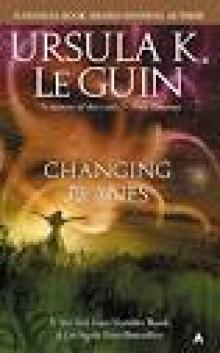 Ursula K. Le Guin
Ursula K. Le Guin Dangerous People
Dangerous People Worlds of Exile and Illusion: Rocannon's World, Planet of Exile, City of Illusions
Worlds of Exile and Illusion: Rocannon's World, Planet of Exile, City of Illusions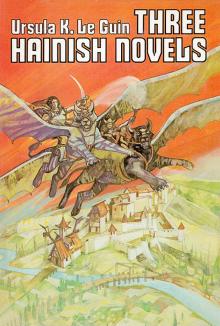 Three Hainish Novels
Three Hainish Novels The Left Hand Of Darkness (SF Masterworks)
The Left Hand Of Darkness (SF Masterworks) The Unreal and the Real - Vol 1 - Where On Earth
The Unreal and the Real - Vol 1 - Where On Earth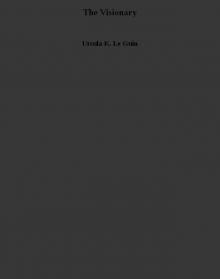 The Visionary
The Visionary The Ones Who Walk Away from Omelas
The Ones Who Walk Away from Omelas The Word for World is Forest
The Word for World is Forest Always Coming Home
Always Coming Home The Unreal and the Real - Vol 2 - Outer Space, Inner Lands
The Unreal and the Real - Vol 2 - Outer Space, Inner Lands Malafrena
Malafrena The Lathe of Heaven
The Lathe of Heaven Five Ways to Forgiveness
Five Ways to Forgiveness The Eye of the Heron
The Eye of the Heron Four Ways to Forgiveness
Four Ways to Forgiveness Powers
Powers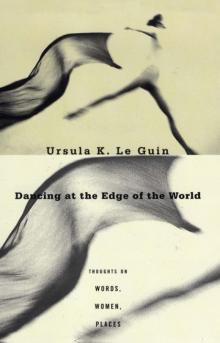 Dancing at the Edge of the World
Dancing at the Edge of the World Very Far Away from Anywhere Else
Very Far Away from Anywhere Else Voices aotws-2
Voices aotws-2 The New Atlantis
The New Atlantis The Unreal and the Real, Selected Stories of Ursula K. Le Guin Volume 1: Where on Earth
The Unreal and the Real, Selected Stories of Ursula K. Le Guin Volume 1: Where on Earth The Telling
The Telling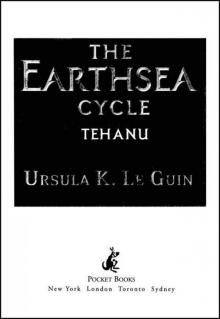 Tehanu (Earthsea Cycle)
Tehanu (Earthsea Cycle) Nine Lives twtq-9
Nine Lives twtq-9 The Birthday of the World and Other Stories
The Birthday of the World and Other Stories The Dispossessed
The Dispossessed Changing Planes
Changing Planes Words Are My Matter
Words Are My Matter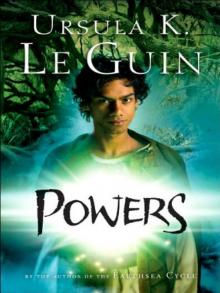 Powers aotws-3
Powers aotws-3 Lavinia
Lavinia The Wind's Twelve Quarters
The Wind's Twelve Quarters Orsinian Tales
Orsinian Tales Gifts aotws-1
Gifts aotws-1 Coming of Age in Karhide
Coming of Age in Karhide The Books of Earthsea: The Complete Illustrated Edition
The Books of Earthsea: The Complete Illustrated Edition The Found and the Lost
The Found and the Lost No Time to Spare
No Time to Spare Voices
Voices The Wild Girls
The Wild Girls Old Music and the Slave Women
Old Music and the Slave Women The Daughter of Odren
The Daughter of Odren A Fisherman of the Inland Sea: Stories
A Fisherman of the Inland Sea: Stories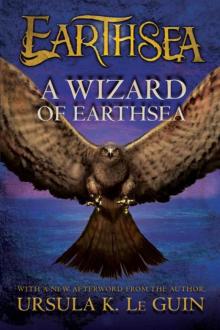 A Wizard of Earthsea (The Earthsea Cycle)
A Wizard of Earthsea (The Earthsea Cycle)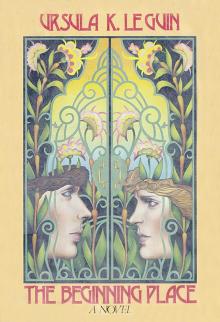 The Beginning Place
The Beginning Place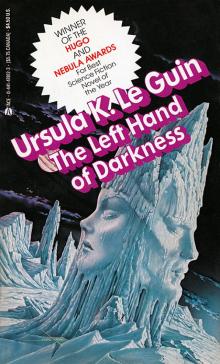 The Left Hand of Darkness
The Left Hand of Darkness The Farthest Shore (Earthsea Cycle)
The Farthest Shore (Earthsea Cycle) The Matter of Seggri botw-2
The Matter of Seggri botw-2